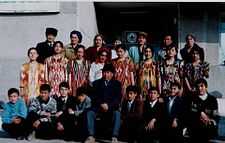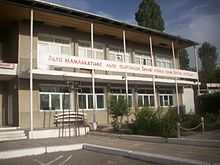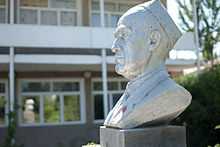Uzbek Gymnasium
| Uzbek Gymnasium Uzbek: Oʻzbek gimnaziyasi, Ўзбек гимназияси | |
|---|---|
| Location | |
|
Isfana Kyrgyzstan | |
| Coordinates | 39°49′59″N 69°32′17″E / 39.8330°N 69.5380°E |
| Information | |
| School type |
gymnasium and boarding-school |
| Religious affiliation(s) | None |
| Established | September 4, 1999 |
| Founder | Jumaboy Boboyev |
| Headmaster | Bumayram Xolmatova |
| Grades | 5-11 |
| Language | Uzbek |
|
The main building of the Uzbek Gymnasium | |
The Uzbek Gymnasium (Uzbek: Oʻzbek gimnaziyasi, Ўзбек гимназияси; Russian: Узбекская гимназия; Kyrgyz: Өзбек гимназиясы) is a gymnasium and boarding school located in Isfana, Kyrgyzstan.[1] The official name of the school is Usmon Matkarimov Gymnasium and Boarding School (Uzbek: Usmon Matkarimov nomidagi gimnaziya-internat, Усмон Маткаримов номидаги гимназия-интернат; Russian: Гимназия-интернат имени Усмона Маткаримова; Kyrgyz: Усмон Маткаримов атындагы гимназия-интернат). The school bears the name of Usmon Matkarimov who served as the head of Isfana's kolkhoz for many years and greatly contributed to the development of the town.[2] The school courses are taught in Uzbek.[3]
Education is free at the Uzbek Gymnasium. Classes are offered for grades five through eleven. The school usually accepts more academically-inclined students. Some of the students, who mainly come from villages located in Leilek District, live in the school boarding house during the academic year.
History
The Uzbek Gymnasium traces its origins to the fall of 1999 when Jumaboy Boboyev, a geography teacher, opened classes for perceptive students in Isfana Secondary School. Mavluda Qoʻldosheva, a teacher of the Russian language, was appointed Head of the Teaching Department. A total of 67 students were selected and divided into four classes. Initially, only twelve instructors taught the students. Over the years, both the number of classes and the number of instructors have increased.
On January 20, 2000, the main office of Isfana's Kolkhoz was acquired to establish the Uzbek Gymnasium as a separate institution. The school has used the two-storied building, which was built in 1982, since that time. In 2000, the school was officially named after Usmon Matkarimov who served as the head of Isfana's kolkhoz for many years and greatly contributed to the development of Isfana and Leilek District. In May of 2000, a bust of Matkarimov was erected in front of the main building of the school.
Shokirjon Toʻychiev served as principal of the Uzbek Gymnasium from 2000 until 2010. He was succeeded by Habibullo Sattorov, who headed the school until 2014. Since 2014 Bumayram Xolmatova has served as principal of the Uzbek Gymnasium.
The following table lists the number of students and teachers for every academic year since the establishment of the school.

| Academic year | Students | Teachers |
|---|---|---|
| 2001 - 2002 | 167 | 18 |
| 2002 - 2003 | 214 | 22 |
| 2003 - 2004 | 231 | 25 |
| 2004 - 2005 | 235 | 27 |
| 2005 - 2006 | 216 | 27 |
| 2006 - 2007 | 203 | 28 |
| 2007 - 2008 | 180 | 28 |
| 2008 - 2009 | 151 | 27 |
| 2009 - 2010 | 169 | 26 |
| 2010 - 2011 | 159 | 27 |
| 2011 - 2012 | 143 | 25 |
| 2012 - 2013 | 130 | 25 |
| 2013 - 2014 | 117 | 21 |
| 2014 - 2015 | 112 | 22 |
Curriculum

At the Uzbek Gymnasium, the seven-year school term is split into middle (grades 5-9) and senior (grades 10-11) classes. Upon completing grade nine, students take state exams and get a certificate confirming their completion of the core nine-year program. Grades 10 and 11 are optional. Students take state exams once again when they finish grade eleven.
The Uzbek Gymnasium accepts more academically-inclined students. Students must take entrance exams to enroll. While the Uzbek Gymnasium provides general education like other secondary schools in Isfana, students of the gymnasium take more classes and have to study harder.
The school curriculum includes subjects like mathematics, informatics, physics, chemistry, geography, biology, arts, music, physical education, history, and astronomy.
The school year extends from the beginning of September to the end of May and is divided into four terms. The school curriculum at the Uzbek Gymnasium is fixed: unlike in some Western countries, schoolchildren cannot choose what subjects to study. Students are graded on a five-step scale, ranging in practice from 2 ("unacceptable") to 5 ("excellent"); 1 is a rarely used sign of extreme failure. Teachers regularly subdivide these grades (i.e. 4+, 5-) in daily use, but term and year results are graded strictly 2, 3, 4, or 5.
Main classes are taught in the morning. In the afternoon, students must attend additional classes. One, two, or three additional classes are taught in the afternoon, depending on the grade. Each class lasts for 45 minutes.
Medium of instruction

The medium of instruction at the Uzbek Gymnasium is Uzbek. In addition to Uzbek, students also study three other languages, namely English, Kyrgyz, and Russian. Like in many other Uzbek-language schools in Kyrgyzstan, the future of teaching in Uzbek remains uncertain at the Uzbek Gymnasium.[4]
Lately Kyrgyz authorities have been taking measures to remove the Uzbek language from public life and have been pushing to forcibly switch Uzbek schools to Kyrgyz.[5][6][7][8][9] There are not enough school textbooks in Uzbek and the Kyrgyz government is unwilling provide them, claiming that it does not have enough funds. As Kyrgyz officials strongly oppose the use of textbooks printed in Uzbekistan, currently the majority of Uzbek schoolchildren in Kyrgyzstan study in Uzbek using Kyrgyz textbooks. In addition, in the past few years the number of teaching hours allocated to Kyrgyz language and literature lessons at Uzbek schools has been significantly increased at the expense of Uzbek language and literature lessons.[10]
Student body
The Uzbek gymnasium has a student government that tries to engage students in learning about democracy and leadership. The student body is run by a president who is chosen by the students of the school in direct elections.
School anthem
The Uzbek gymnasium has an anthem that the students sing along with the National Anthem of the Kyrgyz Republic every morning before school starts. The lyrics of the school anthem were written by Davlatjon Boymatov and the music was composed by Saydulla Mamatqulov. The lyrics are as follows:
|
Ona vatan koʻz tikmoqda bizlarga, |
Ming tashakkur saxovatli elimga, |
Kelajakning poydevori yosh yurak, |
References
- ↑ "Isfana: City profile". The Association of Municipalities of the Kyrgyz Republic. Retrieved 27 October 2014.
- ↑ Aminov, Saitmamat; Maksitov, Tursunbay (2005). Ishak Razzakov's Compatriots (in Kyrgyz). Osh. pp. 385–387.
- ↑ "The Uzbek Gymnasium". The official website of Isfana (in Russian). Retrieved 16 January 2012.
- ↑ Usmon, Sarvar (11 October 2011). "The fate of Uzbek-language schools in Kyrgyzstan is uncertain". RFE/RL's Uzbek Service (in Uzbek). Retrieved 30 October 2012.
- ↑ Sherzod (19 November 2011). "What's the purpose? Increasing illiteracy?". RFE/RL's Uzbek Service (in Uzbek). Retrieved 30 October 2012.
- ↑ Ibraimov, Bakyt; Temir Akmatov (8 December 2011). "Osh mulls ban on Uzbek-language schools". Transitions Online. Retrieved 22 February 2012.
- ↑ Ibraimov, Bakyt; Temir Akmatov (6 August 2012). "Tough talk on Kyrgyz schools". TOL Chalkboard. Retrieved 28 October 2014.
- ↑ Kasym, Elmurad (26 September 2012). "Removing Uzbek from public life". Registan. Retrieved 9 October 2012.
- ↑ Wisniewski, Dan (1 October 2012). "Uzbek language disappearing in Kyrgyzstan". RFE/RL. Retrieved 9 October 2012.
- ↑ Ivashenko, Yekaterina (13 February 2013). "Who needs this Uzbek education". Fergana News (in Russian). Retrieved 15 April 2014.
External links
| Wikimedia Commons has media related to Uzbek Gymnasium. |